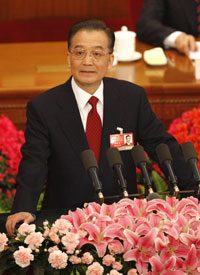
But Americans should be less worried about Jiabao’s March 13 remarks than about economic and financial moves by both China and Japan over the past few months.
Jiabao’s remarks were less based upon communist bellicosity against American capitalism than on the Chinese concern that the United States would further erode, thus cheating the Chinese out of the value of the U.S. debt equities they had purchased. Inflation, after all, is slow-motion repudiation of debt, for the simple reason that the money paid back to the creditor is no longer worth what it once was. And the ultra-low “Federal Rate” pursued by the Federal Reserve Bank over the past year is almost guaranteed to make credit easy and inflate the dollar.
Jiabao pleaded: “I would like to … call on the United States to honour its word and remain a credible nation and ensure the safety of Chinese assets.” That’s not likely, considering the current leadership infesting Washington these days.
It’s hard to blame Jiabao for being concerned about inflation, though inflation may work to the advantage of U.S. taxpayers in this one economic node. (Inflation will be deadly economic medicine for Americans in other areas of the economy.)
But Americans won’t be so lucky with the virtually unreported blockbuster double-whammy of the week: first, America’s two largest foreign lenders (China and Japan) reported suffering a combination of severe economic setbacks that curtail their ability to shell out spending cash. Second, both have initiated broad-based domestic spending policies designed to spend their way out of the recession.
These two trends are virtually guaranteed to dry up the river of money financing U.S. deficit spending.
The Chinese premier’s comment comes just one day after the Japanese government announced that their Gross Domestic Product shrunk by an annualized rate of 12.1 percent in the last quarter of 2008. That’s a three percent loss in value of everything manufactured by the whole country, the worst economic quarter for Japan since 1974.
Although its socialist economy can shield the world from much of the truth, the Chinese economy is also in trouble. Chinese trade exports have fallen off a cliff. “[Chinese] exports in February slid by 25.7 per cent from a year earlier,” the London Times reported on March 12, “dwarfing forecasts of a 5 per cent fall.” Chinese exports are the regime’s source of its immense foreign currency reserves, and it’s also the raw material the Chinese use to purchase U.S. government debt.
The Chinese have apparently taken a cue from the Obama administration on how to get out of their recession: spend, spend, spend. Unlike the United States, however, the Chinese government has some cash on hand to spend.
The Chinese government planned a $586 billion spending “stimulus” package several months ago that’s different from the recently enacted U.S. $787 billion stimulus in one critical way: the Chinese economy is one-fourth the size of the U.S. economy. So their “stimulus” package is the equivalent of $2 trillion in spending by the U.S. government.
Moreover, Jinbao unveiled a second “stimulus” package during his March 13 speech. “Apart from the 4-trillion-yuan ($586 billion) package,” Jiabao announced, “China will cut taxes by 600 billion yuan, raise the old-age pension for retirees, hike the salaries of 12 million teachers, increase farmers’ income and provide more subsidies for them, and spend 850 billion yuan on reforming the health care sector within three years.”
With a declining supply of foreign reserve dollars flowing into its export-based economy and increased domestic spending, there’s going to be a lot less Chinese money available to fund the record issuance of U.S. debt. The U.S. federal government needs to float $2.5 trillion in debt this year under Obama’s budget, including at least $1.75 trillion in new debt.
The Japanese government is the U.S. government’s second largest creditor and has also decided to spend its way out of its current economic crisis. The Japanese are planning a 20 trillion yen ($204.7 billion) “stimulus” plan unveiled March 13, which is the third installment of Japan’s version of Obamanomics. “Bond supply will be the key factor as the weaker the economy, the stronger and larger the stimulus package has to be,” Yuuki Sakurai of Tokyo’s Fukoku Mutual Life told Bloomberg.com.
Bond supply will be the key factor for the United States government as well over the next year, especially if the Japanese government floods international financial markets with its own debt mechanisms and competes against U.S. debt for investors’ money. Sakurai’s philosophy of deficit spending has been fully embraced by Washington, Tokyo, and Beijing. But more government spending is only guaranteeing a longer and stronger recession. More government spending generates more government debt offerings, which sucks the capital out of stock markets that are needed for investments to grow out of the recession.
Unless there is a change of philosophy in Washington, Americans could see a perpetual financial spiral downward … until the government printing presses run out of zeroes, anyway.
— Photo: AP Images



